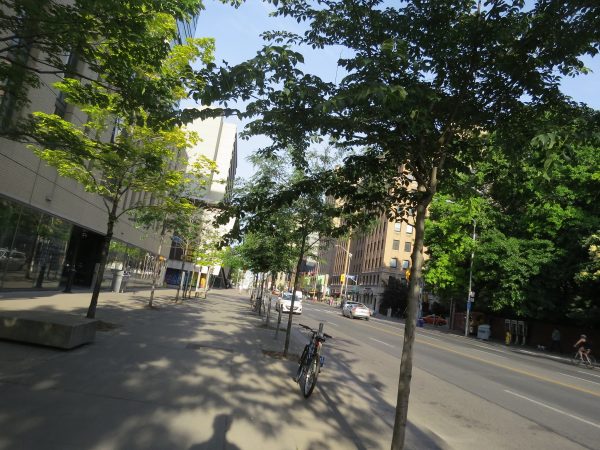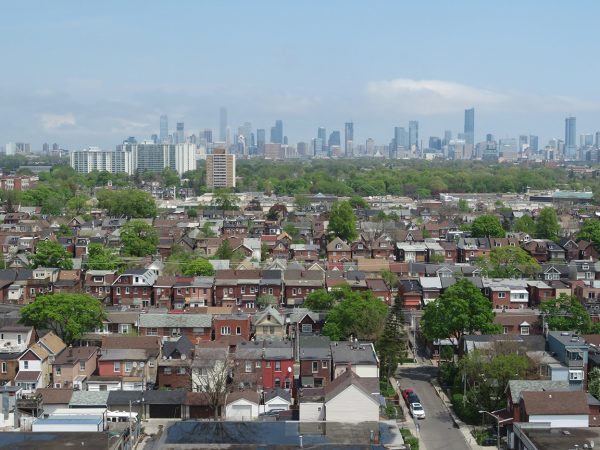Todd Irvine is an arborist (cityforest.ca) and a co-founder of Spacing. This article is reprinted from issue 58 of the magazine.
For anyone who has ever sought refuge under the canopy of a tree on a sweltering summer day, the cooling provided by its leafy shade is undeniable. Studies have found that the ground under the shade of a large tree can be as much as 25 degrees Celsius cooler than unshaded surfaces. And if that was not enough, through the process of evapotranspiration, a single large tree can take up over 400 litres of water from the ground each day, dispersing that moisture into the air as a cooling vapor. These properties make trees a powerful tool in our efforts to keep cities and their residents safe and comfortable in the face of the rising temperatures associated with climate change.
Yet, just sticking more trees in the ground will not be enough. The increased heat and droughts of climate change create their own challenges for trees and are forcing us to rethink how we grow and care for them in our cities.
As I travel the city in my job as an arborist, I’m always obsessively noting how trees are performing. What is becoming obvious is that our old ways of growing urban trees are failing. Trees surrounded by concrete, or planted and left to fend for themselves in the middle of a park of hard-packed turf, are by mid-summer showing scorched leaves with curled-up orange edges, the result of sustained hot air and lack of water in the ground. Their canopies are thin, with leaves dropping early. Many trees, both young and old, are simply dying from the stress.
Trees need a few simple things to thrive: sunlight, moisture, healthy soil, nutrients, and lots of space to grow (both above and below ground).
Sunlight is available in abundance, but can easily be limited by the shade of tall buildings. As such, it’s important to always evaluate how much light is available, and to plant shade-tolerant trees when access to sunlight is low.
But as the climate continues to change, the heat the sun provides will increase, and the make-up of trees that our region will be able to support will evolve. Modelling has shown that forests will shift north. In many cases, the beginning of this shift has already begun. Trees from more northern regions and other parts of the world that we used to be able to grow in our cities are going to suffer from the heat and begin to die. Planting trees historically native to this region must be the priority, but with an added focus on introducing more trees from the Carolinian forest directly to our south, such as sweetgum, black gum, and tulip trees, all better able to cope with the warmer temperatures and longer growing season. This is a delicate process that requires the support of research and constant evaluation of successes and failures.
Growing our urban forest in the face of climate change also requires that we dedicate more space to trees and their thirsty roots. In ideal growing conditions, the majority of a tree’s roots are in the top 60 centimetres of soil, in a vast mat of tiny absorbing roots that often extends out twice the width of a tree’s canopy. They are spread out near the surface so they can absorb as much rainwater as possible. This feature is especially important in hot summer months when rain falls infrequently, but in significant quantities over a short period of time during storms. However, in an urban setting, the below-ground space is limited. Tree roots must compete with buried utilities, building foundations, parking lots, swimming pools, concrete patios, and the many other parts of our built environment.

The ideal solution is to plant trees in large beds of open soil, covered in organic mulch to keep their roots cool and moist. Where space is limited, elaborate below-ground channels of soil can be constructed under sidewalks and parking lots, a technique forestry departments across Canada have been perfecting over the last couple decades. But this process is expensive, and a distant second best. We need to think of ways to replace hard surfaces with soft soil. Homeowners can forgo paved back-yard patios and big driveways; the city can forgo extra parking spots; schools can replace asphalt yards with gardens and trees.
Once roots have been given space, they need water, and lots of it. Hot summer droughts can be devastating for trees. Every new landscape project, from the tiny backyard redesign to the reconstruction of an entire city park, must prioritize the collection, storage, and use of rainwater to support trees, shrubs, and other native plants. Water gardens, rain barrels, bioswales, and water-harvesting cisterns should be included in all public projects and encouraged through financial incentives on every private property, whether single-family homes, condominium grounds, or industrial parks.
Even with all these improvements, there will still be times when not enough rainwater will fall. In such instances, we need to provide water to our most vulnerable trees, especially the newly-planted and the elder giants near the ends of their lives. Property owners will need to monitor rainfall and be sure to put out soaker hoses or run irrigation systems to help trees through the driest of times. Water trucks can be used by city staff for less accessible public trees in need.
Another consequence of greater temperatures is the drying out of soil, which can starve tree roots and kill the millions of beneficial microscopic organisms and fungi that support them. Spreading compost and mulch under trees insulates roots from extreme temperatures and retains moisture, while also providing nutrient-rich organic matter to be broken down by decomposing organisms in the soil. When necessary, soil can be improved by adding beneficial fungi spores and microbes. Whenever possible, the area below trees should be free of turf grass, which competes with roots for precious rainwater. When leaves fall in autumn, they should be left under trees to decompose and provide organic matter to the soil. The objective should always be to mimic the nutrient-cycling processes of a forest, and by so doing, buffer our urban trees against the pressures of climate change.
More frequent and powerful storms are another expected consequence of climate change that will have an adverse impact on trees in cities. High winds and ice storms can break limbs or cause entire trees to fail. Trees most at risk are those that have pre-existing structural defects, have dead branches, or that have been improperly pruned in the past.
Trees should be regularly inspected by a certified arborist qualified to assess them for potential risk. Dead and broken limbs should be removed and any limbs identified as over-extended should be shortened to reduce the likelihood of failure. Cable supports can be installed between large limbs and bolts can be drilled through trunks where a crack or other weakness is present. And every effort must be made to protect tree roots from damage. Roots anchor a tree in the ground, so if they are cut during construction or die in unhealthy soil the result can be the tree blowing over in a storm.
If we keep our trees healthy, properly pruned, and provided with additional support when necessary, they will be much better equipped to survive future storms. This support is vital if we want them continue to provide their many other benefits such as cooling our homes, filtering pollution, managing storm water, and producing oxygen.
Climate change threatens to make our cities hotter, more hostile places to live. But we need not resign ourselves to this future. Trees, and the urban forest they make up, represent perhaps the most effective, and in many ways, easiest, way to keep our cities healthier and more hospitable for all residents. It will take additional resources and city staff to provide the added care trees will require. The same extra time and care will need to be shown by private property owners as well. It will also require we give some things up: that bigger driveway, the water-hogging front lawn, the extra parking spot downtown. These investments and sacrifices will ensure the extra space and resources our trees need to thrive, which in turn will grow and strengthen the green canopy of protection over our cities. If we take care of our trees, our trees will take care of us. If not, out cities are going to be a lot less bearable places to live. The choice is ours.
photos by Sean Marshall and Andy Nystrom




